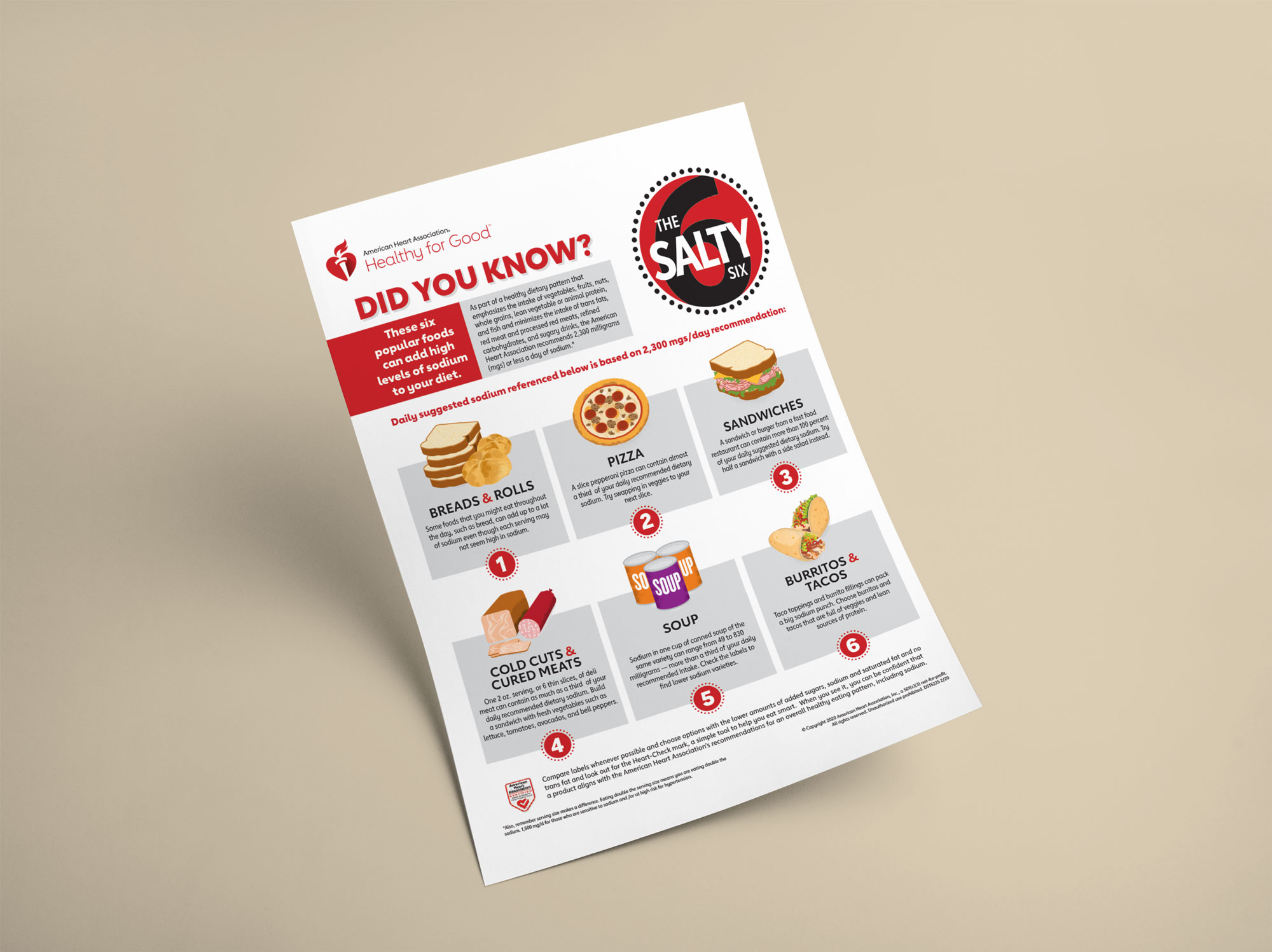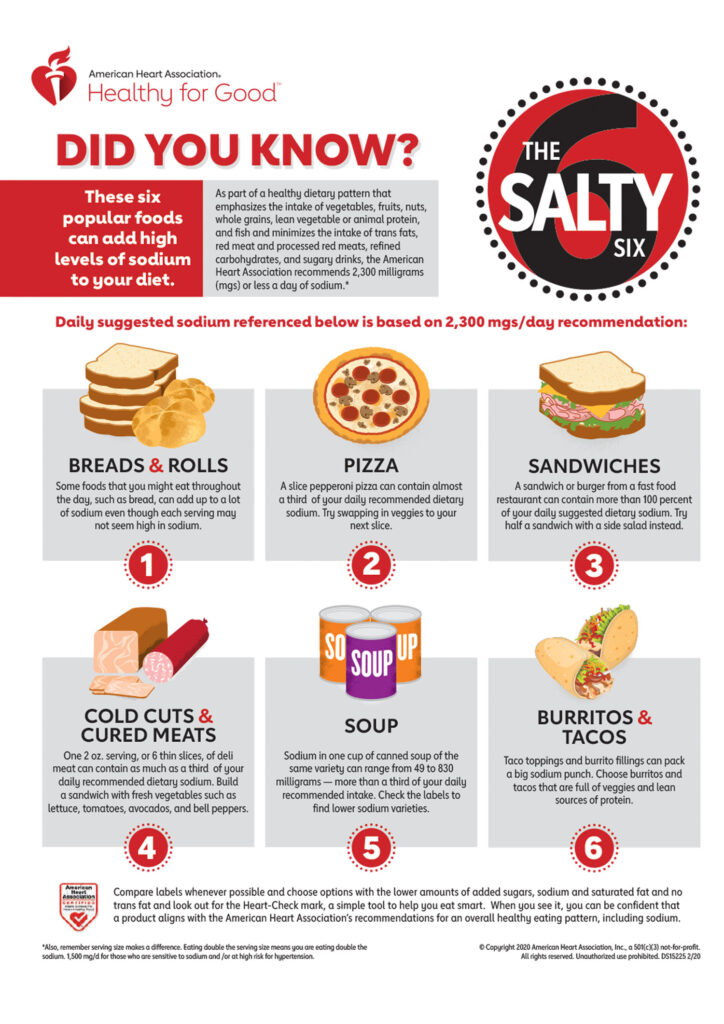Don’t Break My Heart
Excessive sodium intake, nearly double the recommended amount, increases the risk of various health issues and high blood pressure, the leading killer of women in the US. To improve heart health, it’s crucial to reduce sodium through steps like reading food labels for lower-sodium options, choosing salt alternatives, and using herbs and spices over high-sodium condiments. Additionally, incorporating seafood and fish into the diet can significantly reduce cardiovascular disease risks.

Three Easy Steps to Help your Heart Health
Adults around the world get nearly 4,000 mg of sodium in their diet every day. This is almost double the daily recommended amount of sodium set by the American Heart Association at less than 2400 mg a day.
Sodium is an essential nutrient that controls blood pressure and is needed to make nerves and muscles work properly, but you need the right amount. When we over-consume sodium, we are putting ourselves at increased risk for many diseases including:
- Stroke
- heart failure
- osteoporosis
- stomach cancer
- kidney stones
- enlarged heart muscle
- headaches
- kidney disease
- puffiness
- bloating
- weight gain
Heart health month gives us time to discuss the most prevalent of those risks, high blood pressure. High blood pressure, or hypertension, happens to be the number one killer of women in the US. High blood pressure leads to heart attacks and kills more than five times than breast cancer each year. Sadly, youth in the United States are also at risk. Kids who have a high- sodium diet are twice as likely to develop high blood pressure as kids who have low sodium diets, putting them at risk for heart disease earlier than their parents ever were.
What can we do?
Diet is the most controllable and impactful step we can take when it comes to high blood pressure and helping our heart health. In just one teaspoon of table salt there is 2300 mg of sodium, so ditching the salt shaker is an excellent first step. But eating low sodium goes beyond that.
Here are three steps you can take to help your heart out.
1. Read food labels and choose lower sodium options.
- More than 75% of the sodium we consume is in the ingredients or packages we buy at the grocery store. To reduce sodium intake, we must read labels and choose lower-sodium options. When filling up your cart, look before you head to the checkout line. Do you have mostly boxed and packaged foods? Maybe take some time and put some boxed items back and trade out for more fresh or frozen produce. You will automatically reduce the sodium in your diet. Aim to fill up half of your cart with fresh and frozen fruits and vegetables such as leafy greens and frozen berries, lean proteins such as rainbow trout, and whole grains such as brown rice.
The American Heart Association has identified the Salty Six which is a great place to look where you need to reduce sodium in your diet.

2. Look for salt alternatives
- Sea Salt vs. table salt- Some prefer sea salt, or Kosher salt, over table salt for its coarse, crunchy texture and stronger flavor. It is important to know there is little difference between the two, as far as sodium goes. Table salt and most sea salts all contain about 40 percent sodium by weight. However, Kosher salt and some sea salts may have larger crystal sizes than table salt so they may have less sodium by volume. A teaspoon of table salt has about 2,300 mg of sodium, but a teaspoon of sea salt or kosher salt may have less sodium because fewer crystals fit on the spoon, resulting in using less in our foods and recipes. Most sea salts don’t offer any real health advantages so be aware of false health claims on the labels. Sea salt contains less iodine, an essential nutrient to prevent goiter, than table salt so there may not be a benefit to switching it out. It comes down to taste preference on which salt you should use.
- Use Herbs and Spices: Avoid using prepackaged seasoning mixes because they often contain a lot of salt. Many herb and spice blends are super easy to make yourself. A great tip from the American Heart Association, when using dried herbs and spices, is to add them at least 15 minutes before they are done cooking for full flavor. Add fresh right before serving to avoid flavor loss or wilting.
Try this favorite seasoning blend on your fish and seafood:
-
- 1 Tbsp paprika
- 1 tsp dried rosemary
- 1 tsp garlic powder
- 1 tsp dried parsley
- 1 tsp dried dill weed
- ½ tsp ground black pepper
3. Select condiments with care
- Soy sauce, bottled salad dressings, dips, ketchup, jarred salsas, capers, mustard, pickles, olives, and relish, can be overloaded with sodium. Look for a reduced- or lower-sodium version. One easy trick when looking at a food label is to glance over at %DV (% daily value). If it is over 10%, it is considered high, and you probably want to select another food. Use flavored vinegars and fresh citrus juices in place of high sodium condiments in your recipes.
- Focusing on reducing sodium intake alone isn’t the whole answer. It is crucial we all focus on eating higher quality, nutrient-dense foods. If we are eating a lot of high-sodium foods, it’s often a sign that our overall diet isn’t as nutritionally balanced as it should be. Start taking these steps to reduce your sodium in your diet and over time your taste buds will adjust to liking less salt.
As a dietitian, I also encourage you to add seafood and fish into your diet at least twice a week. Research has shown us it reduces early death by cardiovascular disease by at least 50%! Try it and see for yourself, your heart will thank you!